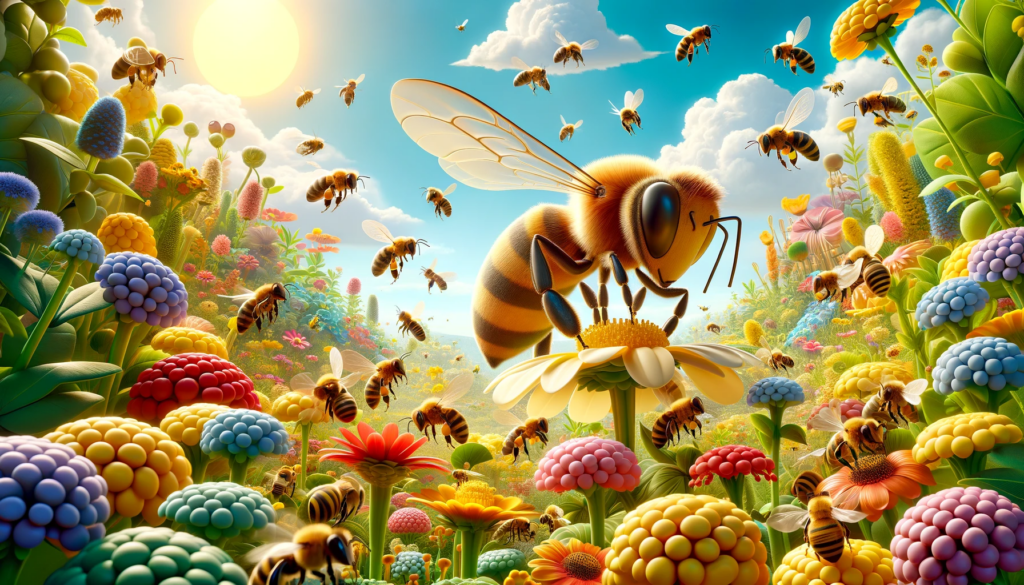World Bee Day

World Bee Day is an important day celebrated on May 20th. This day was chosen because it is the birthday of Anton Janša. He was a pioneer of modern beekeeping from Slovenia long ago.
World Bee Day aims to raise awareness about the importance of bees. Without bees, many plants we rely on would not grow well. Bees play a vital role in pollinating flowers, fruits, and vegetables. Without their work, our food supply would be in great danger. Many bees are dying because of pesticides and climate change. These factors put our food and our environment at risk.
People around the world do different activities to celebrate this day. Some plant flowers that attract bees, like sunflowers and lavender. Others avoid using harmful pesticides in their gardens. Schools may teach students about the vital role bees play in our lives. Many also organize events to inform the public about how to protect bees. By doing these things, we can help create a better world for bees.
Remembering the efforts of every bee helps us appreciate their tiny work. Celebrate World Bee Day by learning how you can help save the bees. Every small action can make a big difference in saving them.
General Level: B1.1
Vocabulary: A2.9
Verb Form: A2.0
Clause: B1.0
Wordlist
awareness NOUN B2 1
Definition (En):
- having knowledge of
n. state of elementary or undifferentiated consciousness
beekeeping NOUN +∞ 1
Definition (En):
- the cultivation of bees on a commercial scale for the production of honey
harmful ADJ B2 1
Definition (En):
- causing or capable of causing harm
lavender NOUN C2 1
Definition (En):
- any of various Old World aromatic shrubs or subshrubs with usually mauve or blue flowers; widely cultivated
n. a pale purple color
s. of a pale purple color
pesticide NOUN B2 2
Definition (En):
- a chemical used to kill pests (as rodents or insects)
pioneer NOUN C1 1
Definition (En):
- someone who helps to open up a new line of research or technology or art
n. one the first colonists or settlers in a new territory
v. open up an area or prepare a way
v. open up and explore a new area
pollinate VERB C1 1
Definition (En):
- fertilize by transfering pollen
rely VERB B2 1
Definition (En):
v have confidence or faith in
sunflower NOUN B2 1
Definition (En):
- any plant of the genus Helianthus having large flower heads with dark disk florets and showy yellow rays
vital ADJ B2 2
Definition (En):
- performing an essential function in the living body
s. manifesting or characteristic of life
Phrases and Idioms
Lemma | Sentences |
aim to | · World Bee Day aims to raise awareness about the importance of bees. |
at risk | · These factors put our food and our environment at risk. |
because of | · Many bees are dying because of pesticides and climate change. |
long ago | · He was a pioneer of modern beekeeping from Slovenia long ago. |
play in | · Schools may teach students about the vital role bees play in our lives. |
True / False / Not Given
- Anton Janša was born on the day World Bee Day is celebrated.
- The main goal of World Bee Day is to let people know how crucial bees are.
- Bees are responsible for the growth of all plants.
- Climate change has no effect on bee populations.
- Schools do not participate in World Bee Day activities.
- People celebrate World Bee Day by only planting flowers.
- Every bee’s efforts are remembered on World Bee Day.
- Anton Janša invented modern beekeeping technology.
- All the activities on World Bee Day help protect bees.
- Using more pesticides is encouraged on World Bee Day.
Multiple Choice
1) Why was May 20th chosen for World Bee Day?
a) It is the birthday of Anton Janša.
b) It is the day many flowers bloom.
c) It is the end of spring season.
d) It is the start of beekeeping year.
2) What happens to plants without bees?
a) They attract more insects.
b) They grow faster.
c) They do not grow well.
d) They change color.
3) What roles do bees have in our environment?
a) Pollinating flowers, fruits, and vegetables.
b) Making the soil rich.
c) Controlling pests.
d) Cleaning water sources.
4) What is a cause of many bees dying?
a) Too many flowers.
b) Pesticides and climate change.
c) Windy weather.
d) Lack of trees.
5) What can people do to celebrate World Bee Day?
a) Avoid planting any flowers.
b) Catch bees and keep them.
c) Stop walking in parks.
d) Plant flowers that attract bees.
6) What do schools do on World Bee Day?
a) Teach students about bees.
b) Give students honey.
c) Release bees in classrooms.
d) Stop using pesticides.
7) What is the overall message of World Bee Day?
a) Building more roads is good for bees.
b) Using more pesticides is important.
c) Cutting down trees helps bees.
d) Helping save bees can make a big difference.
Short Answer Questions
- Why is World Bee Day celebrated on May 20th?
- What is the main aim of World Bee Day?
- What roles do bees play in the environment?
- What puts bees and our food at risk?
- How do people celebrate World Bee Day?
- How can schools participate in World Bee Day?
7. What is a small action that can help save bees?
True / False / Not Given Answers
- True
Explanation: The text states that World Bee Day coincides with Anton Janša’s birthday.
(“This day was chosen because it is the birthday of Anton Janša.”)
- True
Explanation: World Bee Day is described as a means to raise awareness about bees’ importance.
(“World Bee Day aims to raise awareness about the importance of bees.”)
- False
Explanation: The text states ‘many plants’ rely on bees, not all plants.
(“Without bees, many plants we rely on would not grow well.”)
- False
Explanation: The text mentions that climate change, along with pesticides, is causing bee deaths.
(“Many bees are dying because of pesticides and climate change.”)
- False
Explanation: The text indicates that schools may be involved in teaching about bees, hence participating in World Bee Day.
(“Schools may teach students about the vital role bees play in our lives.”)
- False
Explanation: The text lists multiple ways people celebrate World Bee Day, not just planting flowers.
(“Some plant flowers that attract bees, like sunflowers and lavender. Others avoid using harmful pesticides in their gardens.”)
- True
Explanation: The text encourages remembering every bee’s efforts on World Bee Day.
(“Remembering the efforts of every bee helps us appreciate their tiny work.”)
- Not given
Explanation: The text does not provide information about Anton Janša inventing modern beekeeping technology.
(“N/A”)
- True
Explanation: According to the text, all activities on World Bee Day are aimed at helping and protecting bees.
(“Many also organize events to inform the public about how to protect bees. By doing these things, we can help create a better world for bees.”)
- False
Explanation: The text mentions that avoiding harmful pesticides is one of the activities promoted on World Bee Day, not using more pesticides.
(“Others avoid using harmful pesticides in their gardens.”)
Multiple Choice Answers
1.
Answer: A
Explanation: The text states that May 20th was chosen as World Bee Day because it is the birthday of Anton Janša.
Answer location: “This day was chosen because it is the birthday of Anton Janša.”
2.
Answer: C
Explanation: The text explains that without bees, many plants we rely on would not grow well.
Answer location: “Without bees, many plants we rely on would not grow well.”
3.
Answer: A
Explanation: The text highlights that bees are vital for pollinating flowers, fruits, and vegetables.
Answer location: “Bees play a vital role in pollinating flowers, fruits, and vegetables.”
4.
Answer: B
Explanation: The text indicates that pesticides and climate change are causing many bees to die.
Answer location: “Many bees are dying because of pesticides and climate change.”
5.
Answer: D
Explanation: The text suggests planting flowers that attract bees as one of the ways to celebrate World Bee Day.
Answer location: “Some plant flowers that attract bees, like sunflowers and lavender.”
6.
Answer: A
Explanation: The text mentions that schools may teach students about the importance of bees on World Bee Day.
Answer location: “Schools may teach students about the vital role bees play in our lives.”
7.
Answer: D
Explanation: The overall message is that every small action can help save the bees and make a big difference.
Answer location: “Every small action can make a big difference in saving them.”
Short Answer Answers
1.
Answer: It is the birthday of Anton Janša.
Explanation: The explanation for why May 20th is chosen is directly stated as it is the birthday of Anton Janša.
Answer location: “This day was chosen because it is the birthday of Anton Janša.”
2.
Answer: To raise awareness about the importance of bees.
Explanation: The text explains that the main purpose of World Bee Day is to raise awareness about bees.
Answer location: “World Bee Day aims to raise awareness about the importance of bees.”
3.
Answer: Pollinating flowers, fruits, and vegetables.
Explanation: The text indicates the specific roles that bees have in the environment.
Answer location: “Bees play a vital role in pollinating flowers, fruits, and vegetables.”
4.
Answer: Pesticides and climate change.
Explanation: The text lists pesticides and climate change as the main threats to bees.
Answer location: “Many bees are dying because of pesticides and climate change.”
5.
Answer: By planting flowers and avoiding pesticides.
Explanation: The text mentions these activities as examples of how people celebrate World Bee Day.
Answer location: “Some plant flowers that attract bees, like sunflowers and lavender. Others avoid using harmful pesticides in their gardens.”
6.
Answer: Teach students about bees.
Explanation: Teaching students about bees is an activity mentioned for schools.
Answer location: “Schools may teach students about the vital role bees play in our lives.”
7.
Answer: Planting flowers that attract bees.
Explanation: Planting bee-attracting flowers is suggested as a helpful small action.
Answer location: “Every small action can make a big difference in saving them.”




